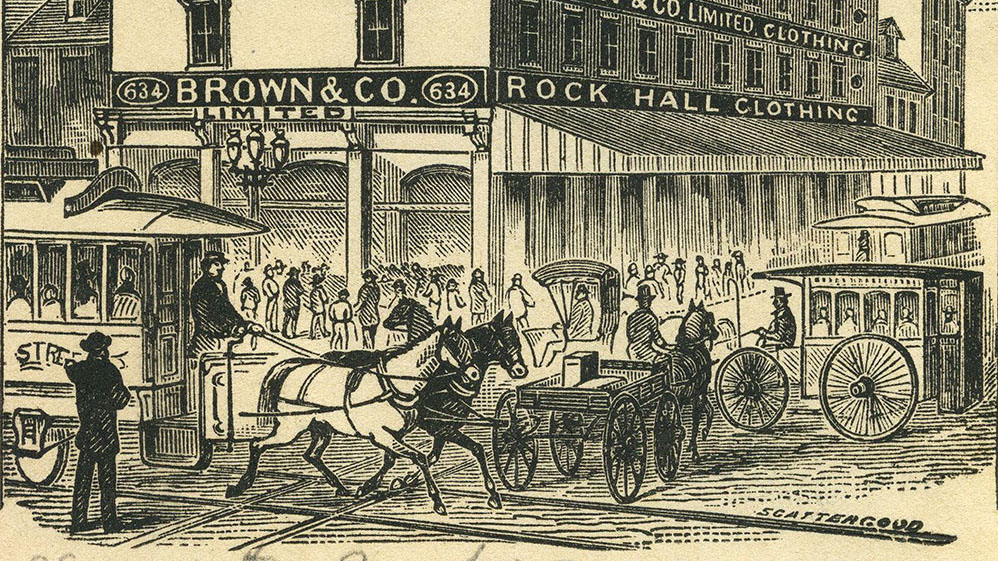One of the things I was really curious about when I started this series was how we came to prioritize vehicles over people in the street. For a brief time during the pandemic, many people were wondering why we had turned over so much of our city to cars. Why did people on small alley streets have to make way for anyone in a car? When did we lose the right to use the street?
Many people point to the coming of the automobile. And there is definitely truth to this. But the automobile just completed a long-term effort to get people out of the street.
Others have blamed the bicycle. Again, the bicycle did play a part. In the late nineteenth century, cycling was extremely popular with the upper classes. They formed influential wheelmen clubs that petitioned government to have streets paved with smooth asphalt, instead of granite block pavers. They literally paved the way for the automobile, which arrived a few decades later.
But Michael Kahan argues that it was the coming of rails on urban streets in the mid-nineteenth century that really got things started. Freight rails were laid down on city streets first, but only on a few streets. It was the lighter, horse-drawn streetcar rails that really claimed the street for traffic. Because streetcars went everywhere.
The 1862 Smedley atlas of Philadelphia shows the delicate rail lines of the horse-drawn streetcar running to the Frankford Arsenal in Bridesburg in the northeast, down past the nurseries and lumber yards of Moyamensing to the south, connecting with the town of Darby to the southwest, fanning out across the growing suburbs of West Philly, and reaching into the industrialized areas of Manayunk and Germantown in the northwest. (Explore the 1862 Smedley maps at PhilaGeoHistory.org)
As the streetcar rails were being built in the streets, people protested and sued in the courts. The legal battles over the right to the street were won by city and state governments, who were given control over what happened within this public space. Governments were given the power to grant charters to private companies for public improvements, like streetcars. Older street traditions of working and socializing in the streets were made criminal, subject to fines.
It was really the railroad, and especially the ubiquitous streetcar, that made traffic a top priority over the use of streets for everyday life.
Bachman’s birds-eye view of Philadelphia, looking west from the Delaware River, in 1850. Admire the variety of vessels gliding and churning through the waterway. Note the market sheds running down the center of Market Street on the right. (The Library Company of Philadelphia.)
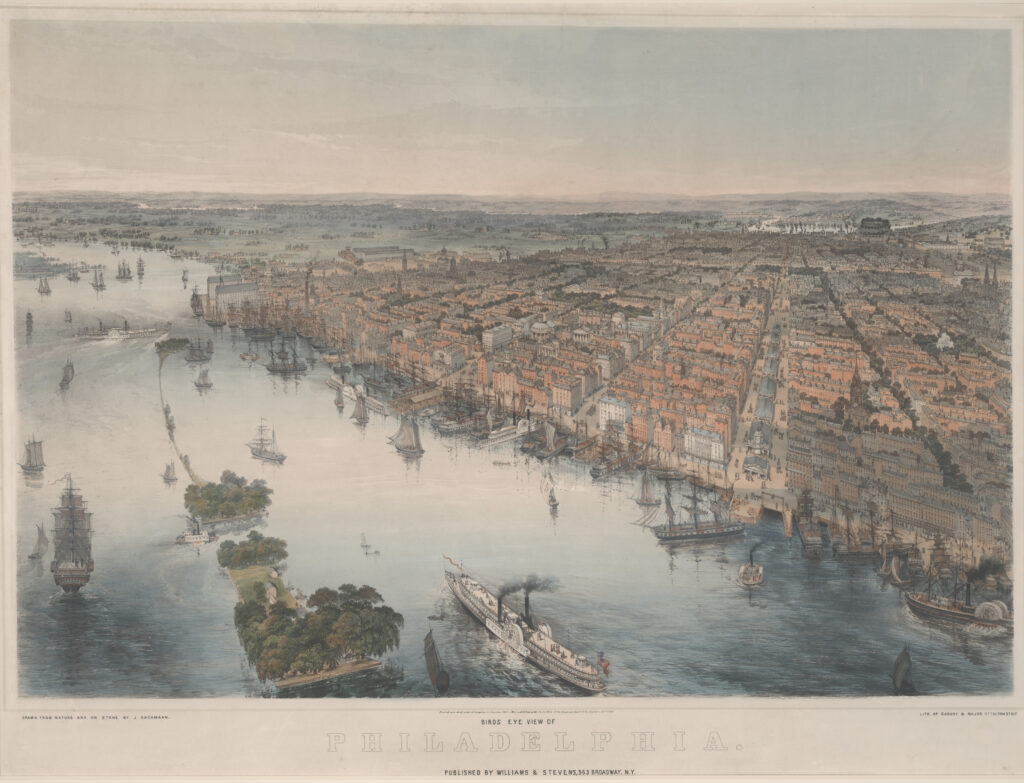
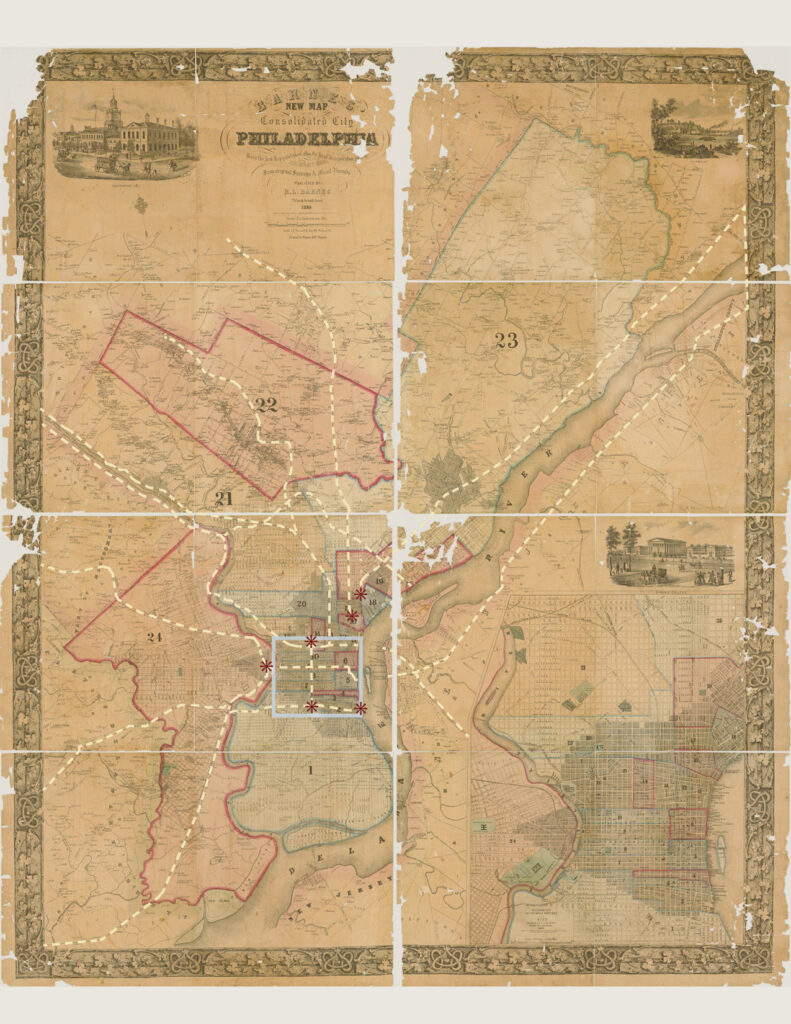
Railroad lines (dashed white lines) and depots (red asterisks) highlighted on the 1855 Barnes Map of Philadelphia, and adjacent parts of New Jersey. The gray box indicates Center City. (Free Library of Philadelphia)
The Merchant’s Exchange building at 3rd and Dock Streets was a major hub of transportation in Philadelphia. This print shows the Exchange surrounded by bright yellow omnibuses with signs indicating their route: West Philadelphia, Navy Yard, Arch Street, etc. (The Library Company of Philadelphia)
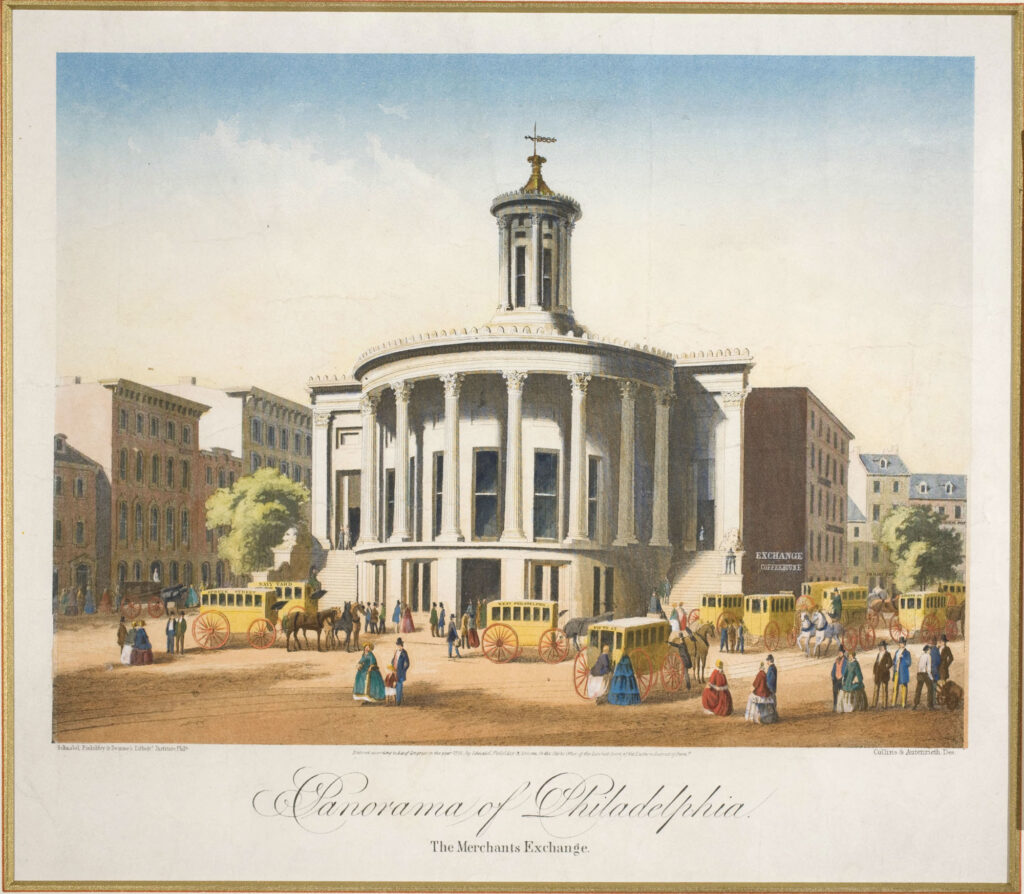

Augustus Kollner’s ominibus of 1855. Kollner was famed for his depiction of horses. But his mini-man child at bottom right shows that he was less skilled with humans. (The Library Company of Philadelphia)
Such a fine establishment! Look at the fine marble in the yard, the massive stone being delivered, the marble statuary above your head. Feel thoroughly up to date browsing the very latest in steam-powered marble work! You will be stepping into the most fashionable show rooms in the Gothic Revival style. And look at the finely dressed customers, stopping by to browse as part of a delightful outing.
In 1859, this advertisement targets the upper middle-class consumer who would be riding the streetcar. The Green and Coates streetcar ran east-west along Coates (now Fairmount Avenue) and Green Streets. This streetcar connected passengers to a steamboat launch just north of the Fairmount Waterworks dam. The steamboat would then take passengers on to Manayunk.
Streetcars soon popped up on advertisements directed towards the wealthy middle classes. The streetcar was a symbol of progress, of being in the middle of big things. It showed that advertisers were targeting a better class of buyers. Those who rode the streetcars every day could see themselves in the hoop-skirted and top hat wearing riders in the ads. (The Library Company of Philadelphia)
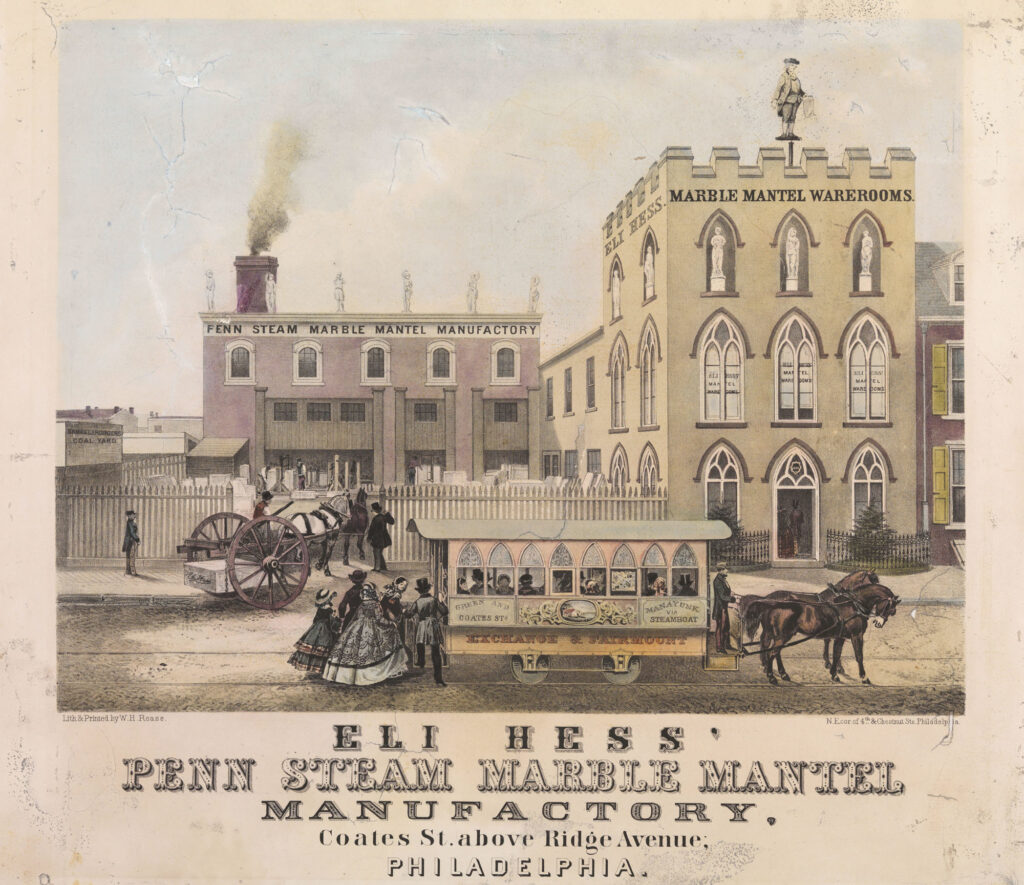
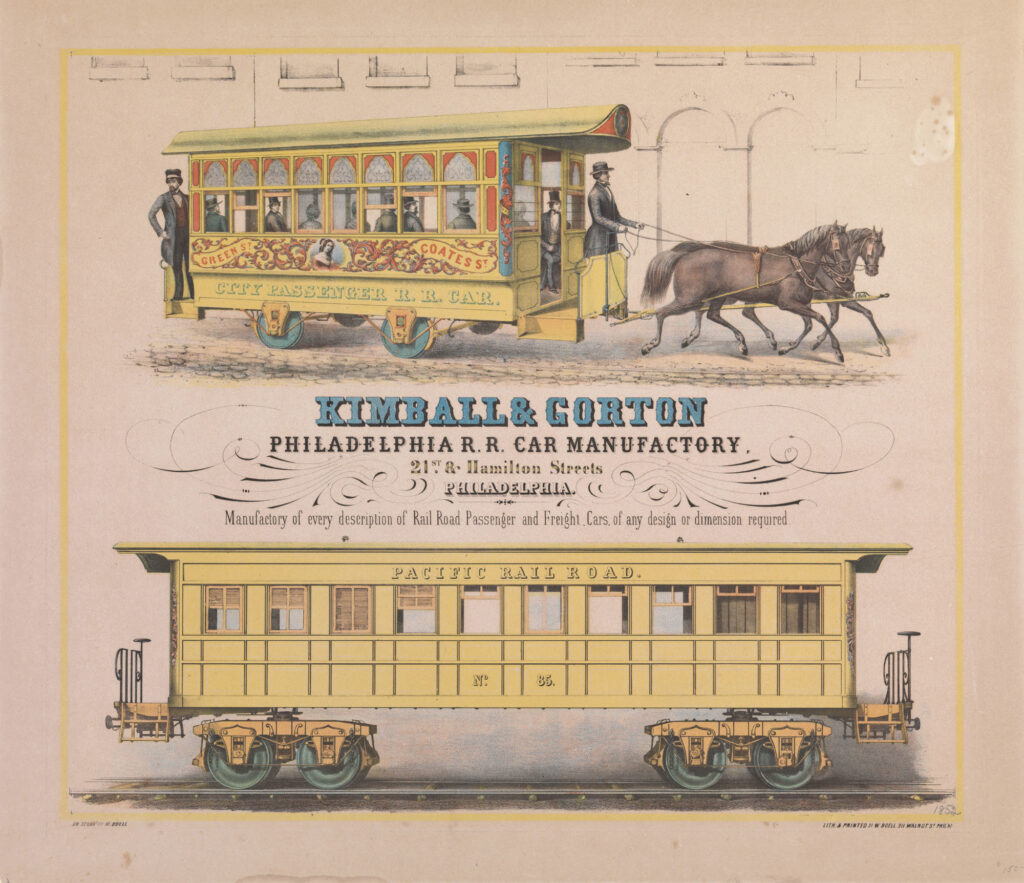
This advertisement from Kimball & Gorton c. 1860 shows the similarities between passenger railcars and horse-drawn streetcars. The Green and Coates (now Fairmount) Streetcar was clearly a showpiece of a car with its bright paint and fancy, gothic-arched glass windows. (The Library Company of Philadelphia)
Market and Seventh Streets in the 1860s shown in this advertisement. Note the omnibus, work wagon, private carriage, and horse-drawn streetcars. (Free Library of Philadelphia.)
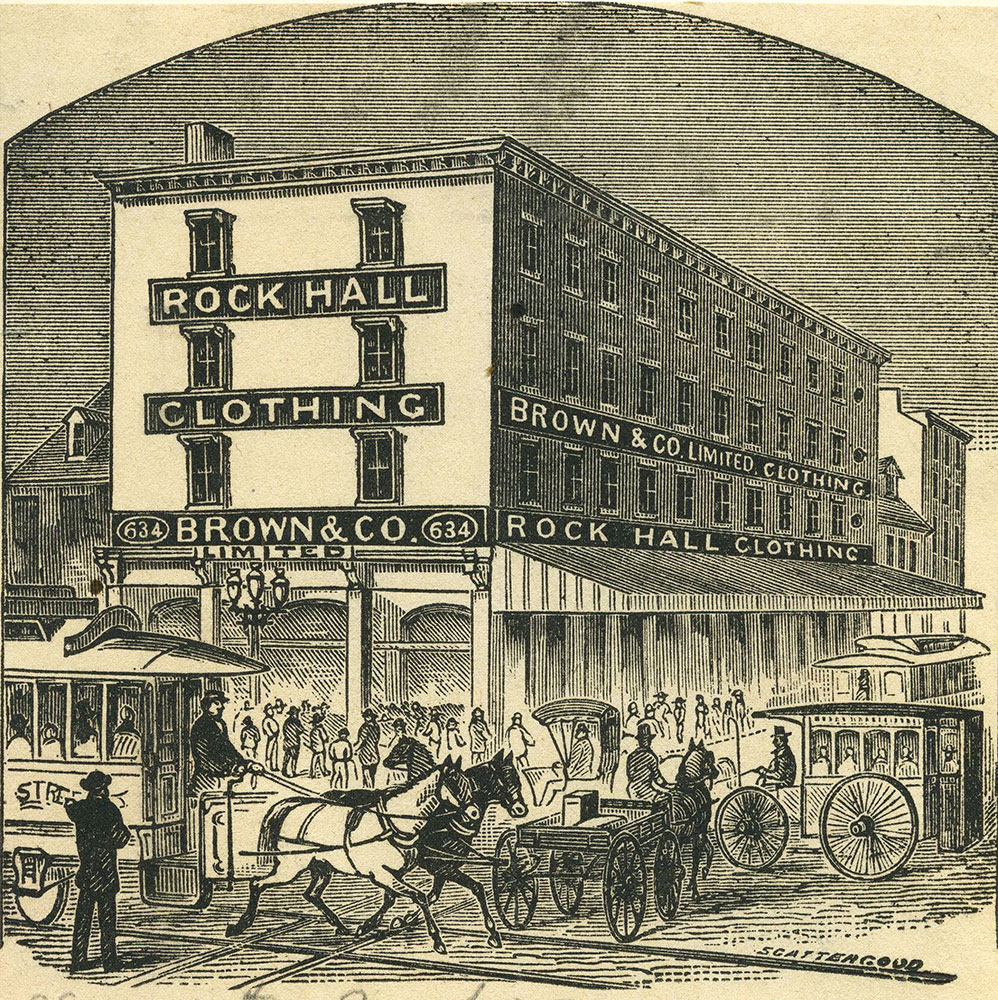
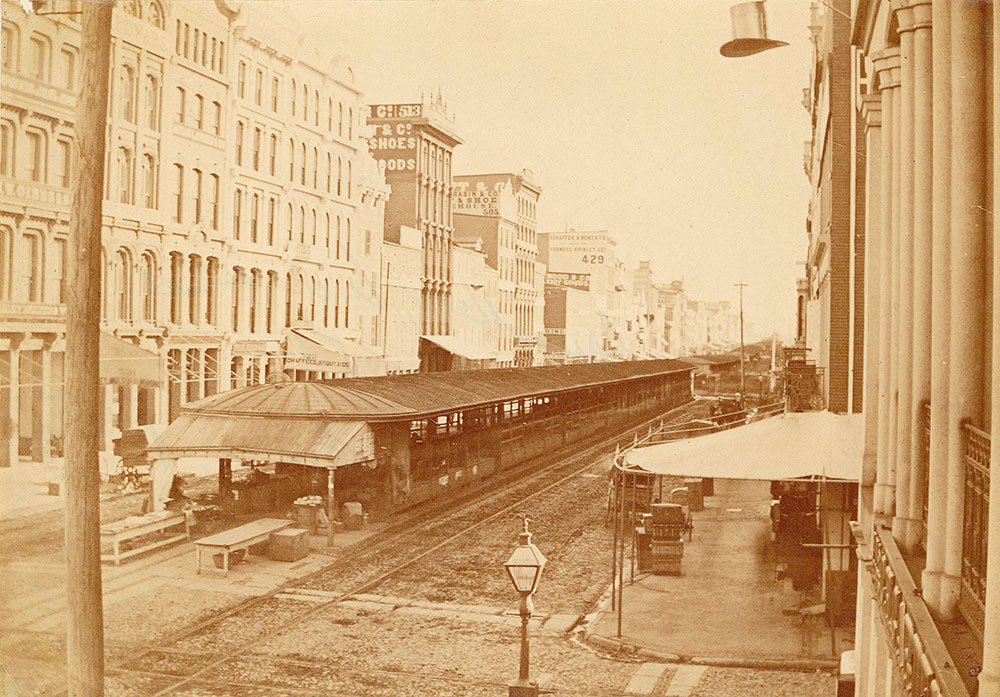
Looking east down Market Street from 6th Street in 1859. At this point, the market sheds were slowly being taken down, block by block. The West Philadelphia streetcar line has been installed on this side of the sheds. (Free Library of Philadelphia)
Stereoscopic view of a horse-drawn streetcar c. 1894. As electric trolleys replaced the horse-drawn streetcar, there was a certain nostalgia for the old cars. This photo was taken at a time when the horse-drawn streetcar was all but obsolete. (The Library Company of Philadelphia)
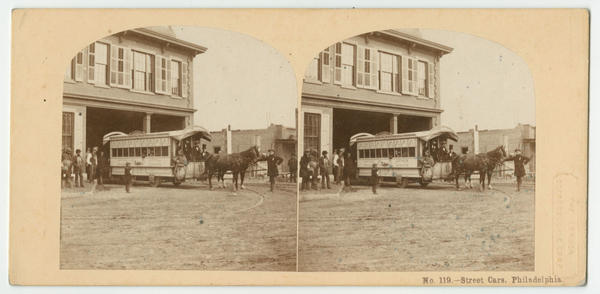
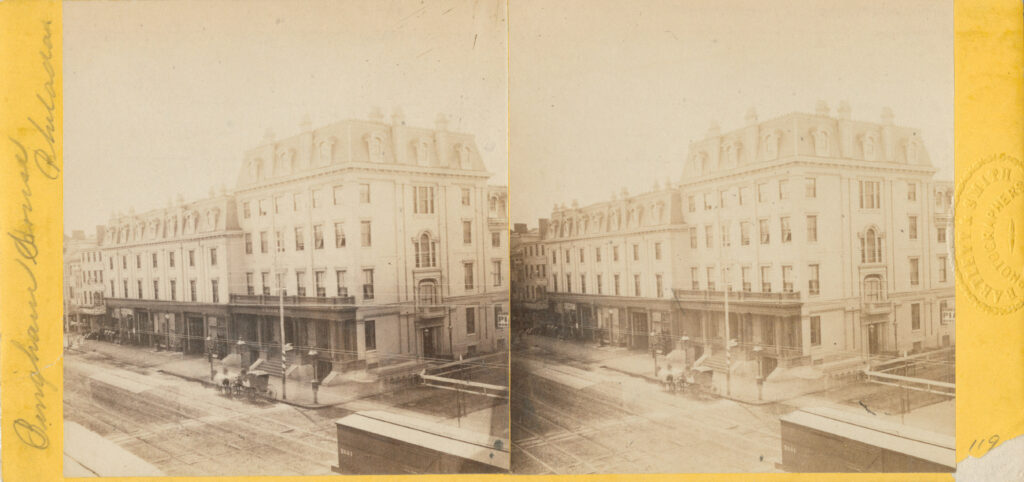
Stereoscopic view of 10th and Market Streets c. 1869. Note the railroad freight car sitting on Market Street at the bottom right of the picture. This photo helps explain why there are no photographs of streetcars in motion in the years before the Civil War. Photography just wasn’t equipped to capture fast-moving objects. If you look closely, there is a “ghost” streetcar just above the railroad car. The streetcar left a faint imprint while it moved through the scene during the camera’s long exposure. The utility pole and wires in this 1869 photo would be for telegraph lines, not electricity yet. (The Library Company of Philadelphia)
Resources
Allinson, Edward P. and Boies Penrose. Philadelphia 1681-1887: a History of Municipal Development. Baltimore, Publication Agency of the Johns Hopkins University. Allen, Lane & Scott, 1887.
Baldwin, Peter C. Domesticating the Street: The Reform of Public Space in Hartford, 1850-1930. Columbus, OH: Ohio State University Press, 1999.
“City Councils. Reported For The Pennsylvania Inquirer.” Philadelphia Inquirer, 11 June 1858, p. 1.
“City Railroads.” Philadelphia Inquirer, 10 Feb. 1858, p. 1.
Daly, John, and Allen Weinberg. Genealogy of Philadelphia County Subdivisions. City of Philadelphia Department of Records: 1966.
Fisher, Sidney. A Philadelphia Perspective : The Civil War Diary of Sidney George Fisher. Edited by Jonathan White. Fordham University Press, 2007.
Foner, Philip S. “The Battle to End Discrimination Against Negroes on Philadelphia Streetcars: (Part I) Background and the Beginning of the Battle.” Pennsylvania History: A Journal of Mid-Atlantic Studies, vol. 40, no. 3 (July 1973), pp. 261-290.
Foner, Philip S. “The Battle to End Discrimination Against Negroes on Philadelphia Streetcars: (Part II) Background and the Beginning of the Battle.” Pennsylvania History: A Journal of Mid-Atlantic Studies, vol. 40, no. 4 (October 1973), pp. 355-379.
Heath, Andrew. In Union There Is Strength: Philadelphia in the Age of Urban Consolidation. University of Pennsylvania Press, 2019. JSTOR, www.jstor.org/stable/j.ctv16t6hgz. Accessed 19 Feb. 2021.
Hepp, John H. The Middle-Class City: Transforming Space and Time in Philadelphia 1876-1926. Philadelphia: University of Pennsylvania Press, 2003.
Hepp, John. “Omnibuses,” The Encyclopedia of Greater Philadelphia, 2012: https://philadelphiaencyclopedia.org/essays/omnibuses/
Kahan, Michael. Pedestrian Matters: The Contested Meanings and Uses of Philadelphia’s Streets, 1850s-1920s. Dissertation. University of Pennsylvania. 2002.
Klepp, Susan E. “Demography in Early Philadelphia, 1690-1860.” Proceedings of the American Philosophical Society, vol. 133, no. 2, 1989, pp. 85–111. JSTOR, http://www.jstor.org/stable/987041
Kyriakodis, Harry. “Long Before the SEPTA Key: A Penny Ride on the Omnibus.” Hidden City, June 28, 2016. https://hiddencityphila.org/2016/06/long-before-the-septa-key-a-penny-ride-on-the-omnibus/
McShane, Clay, and Joel A. Tarr. The Horse in the City: Living Machines in the Nineteenth Century. Baltimore, MD: The John Hopkins University Press, 2007.
“Report of the Board of Experts on Street Paving.” Journal of the Franklin Institute, 1884: 210-223.
“Report of the Committee on the Market Street Sheds.” Philadelphia Inquirer, 23 Sept. 1858, p. 1.
Smedley, Samuel L. Atlas of the City of Philadelphia. Philadelphia: J.B. Lippincott, 1862.
Snead, James E., Erickson, Clark L., and Darling, J. Andrew, eds. Landscapes of Movement : Trails, Paths, and Roads in Anthropological Perspective. Philadelphia: University of Pennsylvania Press, 2009. Accessed December 16, 2021. ProQuest Ebook Central.
Speirs, Frederic W. The Street Railway System of Philadelphia: Its History and Present Condition. Baltimore, MD: The Johns Hopkins Press, 1897.
Still, William. “A brief narrative of the struggle for the rights of the Colored people of Philadelphia in the city railway cars : and a defence of William Still, relating to his agency touching the passage of the late bill.” Read before a large public meeting, held in Liberty Hall, Lombard St. below Eighth, Apr. 8th, 1867.
Strangers Guide in Philadelphia. Philadelphia: Lindsay & Blakiston, 1861.
Tallack, William. Friendly Sketches in America. London: A.W. Bennett, 1861.
Wallace, Paul A. W. “Historic Indian Paths of Pennsylvania.” The Pennsylvania Magazine of History and Biography, vol. 76, no. 4, Historical Society of Pennsylvania, 1952, pp. 411–39, http://www.jstor.org/stable/20088407.
Warner, Sam Bass. The Private City: Philadelphia in Three Periods of Its Growth. Philadelphia, PA: University of Philadelphia Press, 1968.
Zylstra, Geoff D. “Struggle over the Streets: Industrialization and the Fight over the Corporate Control of Street Space in Philadelphia, 1830–1860.” Journal of Urban Technology, vol. 20, no. 3, July 2013, pp. 3–19.
